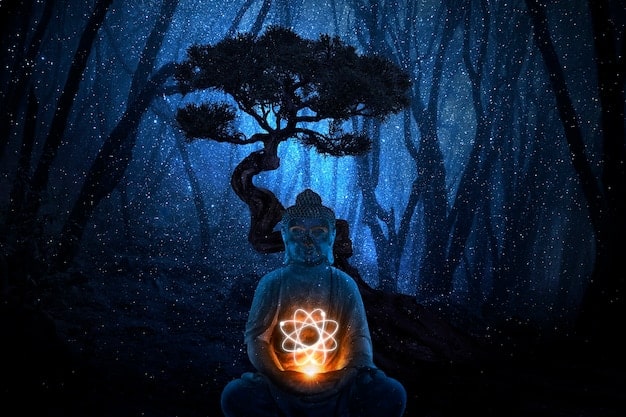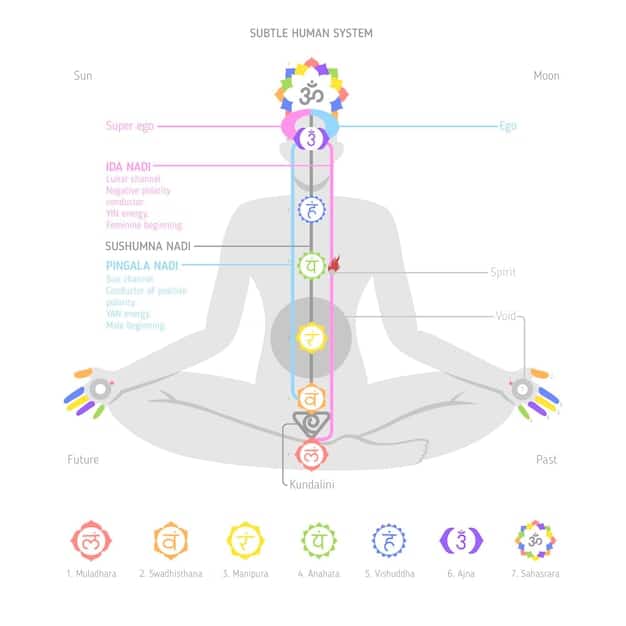Chakra Meditation: A Beginner’s Guide for Enhanced Well-being

Chakra meditation is a practice that involves focusing on the seven energy centers in the body to promote balance, healing, and overall well-being through specific techniques like visualizations, mantras, and guided meditation, fostering a deeper connection with oneself.
Chakra meditation offers a powerful way to enhance your well-being by balancing your energy centers. It sounds complex, but it’s surprisingly accessible to beginners. This guide will walk you through the fundamentals of chakra meditation: a beginner’s guide to balancing your energy centers for enhanced well-being, offering practical tips and techniques to get you started.
Understanding the Chakras
Before diving into chakra meditation, it’s important to understand what chakras are and their significance. These energy centers are believed to influence various aspects of our physical, emotional, and spiritual health. Let’s explore each chakra.
What are Chakras?
Chakras are energy centers within the human body that are thought to regulate its processes, from organ function to immunity and emotions.
The Seven Main Chakras
- Root Chakra (Muladhara): Located at the base of the spine, it’s associated with grounding, security, and survival instincts.
- Sacral Chakra (Svadhisthana): Situated in the lower abdomen, it governs creativity, sexuality, and emotions.
- Solar Plexus Chakra (Manipura): Found in the upper abdomen, it relates to personal power, self-esteem, and willpower.
- Heart Chakra (Anahata): Located in the center of the chest, it deals with love, compassion, and emotional balance.
- Throat Chakra (Vishuddha): Situated in the throat, it governs communication, self-expression, and truth.
- Third Eye Chakra (Ajna): Found between the eyebrows, it’s associated with intuition, insight, and spiritual awareness.
- Crown Chakra (Sahasrara): Located at the top of the head, it connects us to the divine, enlightenment, and universal consciousness.
Understanding these chakras is the first step towards balancing them and improving your well-being.

In summary, each chakra plays a vital role in our overall health. When they are balanced, we experience greater harmony and well-being.
Benefits of Chakra Meditation
Chakra meditation is not just a spiritual practice; it offers a range of benefits for your mental, emotional, and physical health. By regularly practicing chakra meditation, you can unlock these advantages and enhance your quality of life.
Here are some of the key benefits:
- Reduced Stress and Anxiety: Balancing your chakras can help calm the mind and alleviate stress and anxiety.
- Improved Emotional Balance: Chakra meditation can help regulate emotions, promoting a sense of inner peace and stability.
- Increased Self-Awareness: By focusing on your chakras, you can gain a deeper understanding of yourself and your needs.
- Enhanced Creativity: Opening and balancing the sacral chakra can unlock your creative potential.
- Better Physical Health: Chakra balance can positively impact physical health by promoting energy flow and reducing blockages.
These benefits make chakra meditation a worthwhile practice for anyone seeking to improve their overall well-being.
Ultimately, the benefits of **chakra meditation: a beginner’s guide to balancing your energy centers for enhanced well-being** can greatly improve emotional balance and reduced stress.
Preparing for Chakra Meditation
Before you begin your chakra meditation journey, preparation is key. Creating a comfortable and conducive environment can enhance your experience and help you achieve deeper states of relaxation and focus.
Consider these suggestions for preparation:
- Find a Quiet Space: Choose a quiet and peaceful location where you won’t be disturbed.
- Set the Mood: Dim the lights, light a candle, or use aromatherapy to create a calming atmosphere.
- Comfortable Position: Sit comfortably in a chair or on a cushion, ensuring your spine is straight.
- Set Your Intention: Before you begin, set your intention for the meditation, such as balancing a specific chakra.

Ultimately, properly preparing your body beforehand can help increase focus during the meditation.
A little preparation can make all the difference in your chakra meditation practice. A calm and peaceful environment will help you to focus and deepen your experience.
Basic Chakra Meditation Techniques
Now that you understand the chakras and have prepared your space, let’s explore some basic techniques for chakra meditation. These practices are simple yet effective for beginners looking to balance their energy centers.
Guided Meditation
Guided meditation involves following a narrator’s prompts to focus on each chakra individually. This technique is perfect for beginners as it provides structure and direction.
Visualization
Visualization involves imagining each chakra as a spinning wheel of colored light. Focus on the color associated with each chakra and visualize it becoming brighter and more vibrant.
Mantra Chanting
Mantra chanting involves repeating specific sounds or phrases associated with each chakra. This can help to activate and balance the energy center.
These basic techniques offer a gentle introduction to the world of **chakra meditation: a beginner’s guide to balancing your energy centers for enhanced well-being**. Try each one to see which resonates with you the most.
By incorporating these practices into your routine, you can start to unlock the powerful benefits of chakra meditation.
Chakra Balancing Mantras
Mantras can be a powerful tool in chakra meditation, helping to resonate with and activate each energy center. Using the correct mantra can unlock, balance, and energize your chakras, promoting overall well-being.
Here are the corresponding mantras for each chakra:
- Root Chakra (Muladhara): LAM (pronounced “lahm”)
- Sacral Chakra (Svadhisthana): VAM (pronounced “vahm”)
- Solar Plexus Chakra (Manipura): RAM (pronounced “rahm”)
- Heart Chakra (Anahata): YAM (pronounced “yahm”)
- Throat Chakra (Vishuddha): HAM (pronounced “hahm”)
- Third Eye Chakra (Ajna): OM (pronounced “ohm”)
- Crown Chakra (Sahasrara): AH (pronounced “ah”) or silence
To use these mantras, sit comfortably, close your eyes, and repeat the mantra associated with the chakra you wish to balance. Focus on the sound and vibration as you chant.
Regular mantra chanting can significantly enhance your chakra meditation practice, helping you to achieve deeper states of balance and harmony.
In the end, regular mantra chanting can balance multiple chakras and even the body as a whole.
Integrating Chakra Meditation into Daily Life
Integrating chakra meditation into your daily life can bring profound and lasting benefits. Consistency is key, so finding ways to incorporate this practice into your routine is essential.
Consider the following tips:
- Morning Routine: Start your day with a short chakra meditation to set a positive tone.
- Evening Practice: Wind down before bed with a relaxing chakra meditation to promote restful sleep.
- Quick Breaks: Take short breaks throughout the day to focus on balancing a specific chakra.
- Combine with Yoga: Integrate chakra meditation into your yoga practice for enhanced benefits.
By making chakra meditation a regular part of your day, you can cultivate greater balance, peace, and well-being.
| Key Point | Brief Description |
|---|---|
| 🧘 Chakra Definition | Energy centers affecting physical, emotional, and spiritual health. |
| ✨ Benefits | Stress reduction, improved emotional balance, and enhanced creativity. |
| 🧘 Techniques | Guided meditation, visualization, and mantra chanting. |
| 🎵 Mantras | Use specific sounds (LAM, VAM, RAM) to activate each chakra. |
FAQ
▼
Chakras are energy centers located throughout the body, each associated with specific functions, emotions, and aspects of physical and spiritual well-being. Keeping them balanced is key to overall health.
▼
Chakra meditation works by focusing your attention on each chakra, using techniques such as visualization, mantra chanting, and guided meditation to clear blockages and balance their energy.
▼
Yes, many people find chakra meditation to be effective in reducing anxiety by calming the mind, balancing emotions, and promoting a sense of inner peace and relaxation. Regular practice is recommended.
▼
Ideally, you should practice chakra meditation daily for at least 10-15 minutes. However, even a few times a week can bring noticeable benefits. Consistency is more important than duration.
▼
Chakra meditation is generally safe, but individuals with severe mental health conditions should consult a healthcare professional before starting. It’s essential to listen to your body and stop if you feel discomfort.
Conclusion
Embarking on a journey into **chakra meditation: a beginner’s guide to balancing your energy centers for enhanced well-being** can lead to incredible personal growth and well-being. By understanding the chakras, practicing meditation techniques, and integrating them into your daily life, you’ll experience a richer, more balanced existence.





